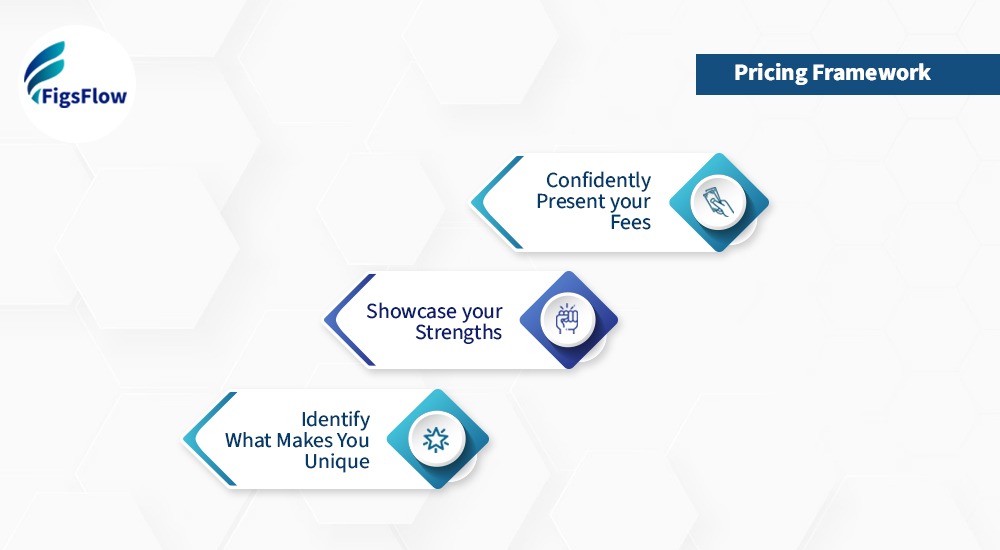Ever felt that awkward pause after quoting your fees to a client? You’re not alone. Many accountants struggle with pricing conversations, especially with new clients.
But let’s be honest, poor pricing communication can be costly to your practice dearly. You could be undercharging for your services while still leaving your clients confused and unaware of what exactly they’re paying for. Or worse, you could be losing your clients entirely.
But don’t worry. In this blog post, we will help you frame your accounting fees clearly and provide practical strategies to handle client pushback without hurting your value.
Sound fair? Let’s dive in.
How To Make Your Pricing More Transparent & Fair?
The first step to good pricing communication is making your pricing feel more transparent, fair and reasonable for the value you provide. This means charging for what you’re truly worth without scaring off your clients.
You can achieve this by properly communicating the reasons behind your figures. When people understand your thought process, they perceive you as a trustworthy individual and prefer to stick with you long-term.
Here’s a simple framework to establish your pricing:

Let’s break it down further.
Identify What Makes You Unique
Before pricing your services, understand what makes you unique.
This could be your unique service offering or the problem you are solving or the thing you do differently from your competitors. It’s important to differentiate yourself and give clients a reason to choose you over your competitors.
Here’s how you can differentiate yourself from the competition:
- Ask clients what they value most
- Evaluate competitors and ask yourself, “What can I do differently to provide more value to clients?”
- Map your services and understand the problems you claim to be solving. Are you saving time? Are you reducing risk? Are you offering peace of mind?
Psychology Tip:
According to some studies, people are more likely to accept a price, even a higher one, if they understand the reason behind it. So, uncover your why (value) that helps explain your fees.
Showcase Your Strengths
Even gold needs a skilled jeweller to reveal its true value. In the same way, your strengths as an accountant need to be clearly communicated to your clients. It’s not enough to be good at what you do; you have to show it in a way that resonates with your customers.
Here’s how you can do that:
- Choose your words wisely. For example, phrases like “Ongoing compliance with peace of mind” provide a greater focus on outcomes rather than, say, phrases like “quarterly filings” which offer little detail and may be too technical. Also, adding “because” to explain your fees where relevant makes clients feel more assured.
- Group your services into bundles to connect with your clients. Doing so enhances clarity and makes clients feel like they are in control.
- Use graphics, visuals, testimonials and real numbers to show the results you deliver. Don’t just tell, show them what you’ve achieved.
Perception Tip:
Do what Apple does. Don’t just sell your services, sell your status, simplicity, story and experiences. People don’t buy services, they buy experiences.
Confidently Present Your Fees
Communicate your fees in a way that feels fair, transparent and confident.
Here’s how you can do this:
- Communicate your fees early — ideally in a proposal, with a clear breakdown of the value your clients will receive.
- Explain any changes in your pricing to your clients.
Perception Tip:
People trust what they see and understand. It's like labels on food packaging — a little transparency goes long way in keeping clients informed, respected and involved.
Talking About Fees Without Making It Awkward
Now, let’s address the elephant in the room: How to talk about fees without making it awkward!
To do this, it’s important to have the pricing conversation at the right time and with the right approach.
When Should You Have the Pricing Conversation?
It’s best to have the pricing conversation as early as possible, ideally in in the client onboarding stage. The longer you wait, the more uncomfortable (and riskier) it becomes.
So, talk about your fees as soon as a client shows interest in your services. Ideally, you should send a personalised proposal detailing your services and their prices. This enhances transparency and allows everyone to get on the same page money-wise before moving forward.
If you’re adjusting your existing fees, it’s good practice to give a notice of 45 to 90 days and clearly explain why you needed to increase your fees.
Pro Tip:
“Oh! Can you just do this too?” Clients tend to do this.
It starts small. Just an additional form or an hour of extra work. But, before you know it, your neck-deep in work that you did not initially agree to and, more importantly, have not charged for. This is what scope creep is, my friend.
But you can avoid this by using FigsFlow. This platform helps you develop proposals that outline exactly what you offer and, should the client ask for extra deliverables, has an advanced pricing calculator to easily calculate the extra fees you need to charge.
No more awkward chats, long pauses or second-guessing. Just professionalism and clarity from day one. Try FigsFlow for Free!
How to Talk About Rates?
Here’s how you can communicate your prices to your clients without making things uncomfortable.
Set Relevant Prices for Your Services
The first step is setting the right prices for your services – prices that sound both reasonable to your customers and compensate you fairly for the value you provide. Then, you can stick with these rates when communicating fees to your potential clients.
To price your services, you can sit down and manually do the math to come up with the charge-out rates that cover your costs. Or you can move beyond traditional hourly billing and adopt value-based pricing model, where you set prices based on perceived value rather than historical charges.
Pro Tip:
MTD is new for you and your clients. If you are scratching your head wondering, “What should I even charge for MTD?”, you are not alone.
Check out our comprehensive guide for pricing MTD ITSA services. It is designed for accountants, bookkeepers and tax advisers and presents practical tips to help you price MTD ITSA services confidently.
Keep Your Proposals Simple & Clear
Use plain language in your proposals and avoid vague terms or hidden extras. Your proposal should clearly answer what exactly the client is going to pay for.
To do this effectively, you need to personalise your proposals to suit the unique requirements of each client.
Highlight Your Strengths
Your proposals should serve as your testimonials, show your track record and showcase your strengths. It should also highlight what you can deliver. This boosts the perceived value of your offer and helps justify your pricing.
Don’t Make Your Proposals Feel Like Sales Brochures
The good proposal should make clients feel supported and involved rather than sold to. You can achieve this by including personalised lines like, “Please feel free to ask any questions. I’d be happy to help.”
Pro Tip:
The best way to communicate your pricing is to let your proposal do the talking. It’s more professional.
You can use FigsFlow to draft professional proposals for your accounting, bookkeeping and tax advisory services. It helps you present your fees confidently, reduces back-and-forth and avoids awkward money conversations.
Conclusion
Communicating pricing with clients is one of the most powerful tools for building long-term relationship and trust. However, if done incorrectly, it can be costly for your practice.
So, it’s important to make your prices more transparent and fairer. The goal here is not to be the cheapest. Rather, it’s about making the client aware of what you offer and why you’re worth their money.
You can do this by using FigsFlow, which lets you craft professional-looking proposals and engagement letters in seconds. It also personalises your service offering for each client without admin and compliance hassles.
Try This Next:
Tweak the way you explain your services to your clients by using “because” and bundle your services in a way that tells a story. It strengthens your position and makes pricing conversations easier.


